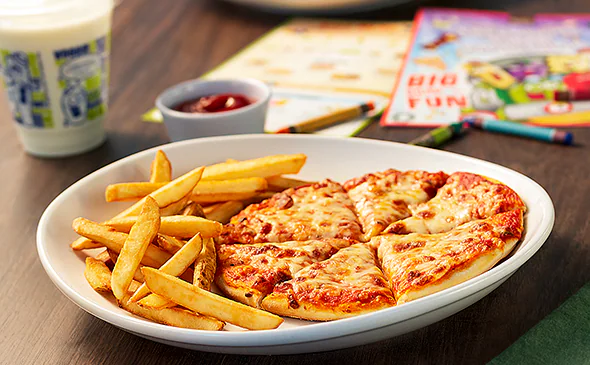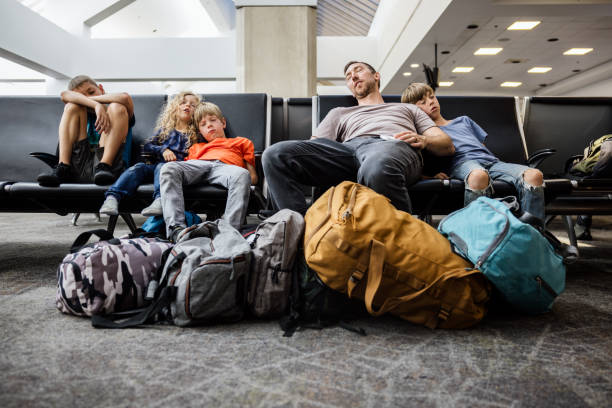A Mama's View on Childhood Across Cultures
Kids in Colombia vs. Dogs in Miami
I just came back from my fifth trip to Colombia, and once again I’m blown away by how different life feels there when it comes to kids. Every visit, I notice more things that make me stop and think: how is it that in a country with fewer resources, children feel so much more included, welcomed, and celebrated than they do here in the United States—especially in Miami, where I live?
It almost feels like two totally different philosophies of childhood are playing out. In Colombia, kids are part of the center of life. In Miami, kids often feel like an afterthought. And as a mom of two, that contrast hits me harder every single time I travel.
The First Clue: Traveling With Kids Starts at the Airport
Let’s start at the very beginning—airport passport control.
If you’ve ever flown internationally with toddlers or babies, you know what a nightmare immigration lines can be. Picture this: you’ve just gotten off a long flight, you’re sweaty, exhausted, balancing a stroller, diaper bag, and two cranky kids who are on the verge of losing it. And then you look up and see an immigration line that snakes around the terminal like Disney World in peak season. Except here, nobody’s handing out Mickey-shaped ice cream.
That’s Miami.
Now let me tell you about Bogotá or Medellín. In Colombia, there are special family lanes at passport control. Moms, dads, babies, strollers—we all get ushered into a dedicated line that moves so much faster. No standing for an hour with a screaming toddler. No death stares from strangers who think your baby’s cries are a personal attack. Instead, it’s an acknowledgment: hey, traveling with kids is hard enough—let’s make this part easier for you.
It’s such a small thing, but it changes the entire tone of arriving in a new country. I instantly feel like Colombia is saying: we see you, parents. You matter. Your kids matter.
Why can’t we have this in the U.S.?
Shopping With Kids: Night and Day
Once you’re actually in Colombia, the differences keep stacking up. Let’s start with something as basic as shopping.
In Miami, when I need clothes for my kids, the options are limited: Target, Carter’s, maybe a couple of other stores if I’m lucky. It’s functional, not fun. Shopping for kids here is like checking an item off a to-do list. There isn’t much joy in it, and the stores definitely aren’t designed for children to enjoy the experience.
Colombia is completely different. There are kids’ clothing stores everywhere—whole sections of malls dedicated to children. You can find shoes, books, toys, entire brands just for them. It’s not like there’s one sad aisle squeezed between electronics and housewares; it feels like kids actually matter.
And while in Miami I usually brace myself for a stressful shopping trip with the kids, in Colombia, I don’t. The malls themselves are designed to make kids happy. Almost every one I’ve been to has a real playground inside. Sometimes even the apartment buildings have them. Imagine going downstairs in your building and having a safe, fun play area for your kids just a few steps away—that’s normal there.
Even bathrooms are thought out. Many public restrooms have small toilets made for kids. The first time I saw one, I laughed because it felt so obvious and yet so rare back home. It’s such a small detail, but as a parent, it makes life so much easier.

Dining Out: Healthy Kids’ Menus vs. Nuggets on Repeat
Eating out is another shocker.
In the U.S., “kids’ menu” basically translates to: chicken nuggets, French fries, mac and cheese, and maybe pizza if you’re lucky. That’s it. It’s the same everywhere—restaurants that pride themselves on “fresh, local, healthy food” for adults still slap the same sad trio on the children’s menu. As a mom, it’s honestly depressing. I don’t want my toddler living off fried food and ketchup packets, but in Miami, that’s the default.
In Colombia, kids’ menus actually look… healthy. You’ll see grilled chicken with rice and veggies, fresh juices, soups made with real ingredients. Restaurants often bring out fruit or natural juice without you even asking. And many places even have little play areas inside the restaurant, so kids can play while parents actually enjoy a meal.
I can’t tell you what a difference that makes. In Miami, eating out with kids feels like a gamble: will they melt down before the food arrives? Will I spend the whole meal cutting nuggets into toddler-sized bites while my food gets cold? In Colombia, I can sit, sip my coffee, and know my kids are happily occupied. It feels like a win for everyone.

Miami’s Lack of Spaces for Kids
Back home in Miami, the difference is obvious.
Finding a play space here feels like a scavenger hunt. Brickell is full of young families, but where are the play areas? Where are the indoor places where kids can run around together, especially when it’s either 95 degrees outside or raining? Miami Beach isn’t much better.
Yes, there are some options.
LouLou House recently opened, and I’ll admit—it’s beautiful. My kids loved it. The problem is the price. For families with more than one child, it adds up quickly. It’s the kind of place you can maybe afford to go once a month, if that. For stay-at-home moms, it’s not realistic to treat it as a regular outing. It’s a “special event” place, not part of everyday life.
Other options? Honestly, they’re kind of sad. The Miami Children’s Museum is good, but it leaves me wanting more. It’s educational, but not a space where kids can really just play together indoors. And sometimes, that’s all we need as parents: a safe, engaging space where our kids can burn off energy and connect with other kids while we catch our breath.
Meanwhile in Miami: More Spaces for Dogs Than for Kids
And here’s the part that really stings.
Miami—and honestly much of the U.S.—feels more dog-friendly than kid-friendly.
In my own building, there’s a dedicated dog area where pets can run and do their business. Except, of course, half the owners don’t bother to pick it up, so stepping through is like navigating a poop minefield. Yet there’s no play space for kids. No small playground. Not even a swing set.
Walk around the city, and you’ll see dog spas, dog bakeries, dog ice cream shops. I’ve even seen people pushing their Yorkies in strollers. Meanwhile, families with kids are stuck figuring out where to go so our little humans can stretch their legs.
It’s ridiculous. We’ve created a culture where dogs are pampered like royalty, while kids—the actual future generation—are treated as an afterthought.
Colombia’s Different Attitude Toward Children
What I’ve come to realize is that Colombia feels so much more kid-centered because of culture.
In Colombia, children aren’t treated like inconveniences. They’re celebrated. Families are central to everything, and you feel that when you’re out in public. Restaurants often have little play zones or activities for kids, so parents can actually enjoy their meal. Apartment buildings almost always come with play areas. Shopping malls expect kids to be there, and they design around that expectation.
In Miami, and in much of the U.S., it’s almost the opposite. Kids are allowed in these spaces, sure, but they aren’t really planned for. Parents are left piecing things together—driving across town to the one decent play area, shelling out money for special indoor playgrounds, or just staying home. It’s not that the U.S. can’t afford to do better. It just doesn’t prioritize it.
Kids in Colombia vs. Dogs in Miami
Colombian Adventures
Street Soccer Games
Neighborhood Hide and Seek
Family Gatherings
Colorful Parks
Miami Luxuries
Dog Spa Days
Pristine Playgrounds
Dog-Friendly Cafes
Designer Strollers
Cultural Differences
Community Spirit
Open Play Spaces
Everyone Knows Your Name
Curated Experiences
"In Colombia, childhood is a symphony of laughter and shared moments. In Miami, it's a curated gallery of polished experiences."
Daryna Star
The Reality as a Parent
As a mom, this hits hard.
Parenting is already overwhelming. Every day is a mix of joy and exhaustion, and having supportive spaces makes a huge difference. In Colombia, I feel like the city has my back. Playgrounds, kid-friendly bathrooms, toy stores, indoor spaces—they’re just there. I don’t have to hunt them down or pay extra.
In Miami, I often feel like I’m fighting the city just to give my kids what they need. By the time I load everyone in the car, drive through traffic, and pay for parking or admission, I’m already drained. And if the place I’ve chosen doesn’t live up to expectations? It’s a double blow.
Traveling to Colombia has shown me that it doesn’t have to be this way. Raising kids doesn’t have to feel so isolating or expensive. With the right public spaces, it can feel communal and joyful.
Why the U.S. Needs to Catch Up
The U.S. has so many advantages—money, technology, innovation. But when it comes to supporting childhood through everyday spaces, we are lagging.
If Colombian malls can have playgrounds, why can’t ours? If Colombian public restrooms can have child-sized toilets, why not here? If Colombian apartment buildings can have play areas built in, why can’t new condo towers in Brickell?
It’s not about copying Colombia exactly—it’s about understanding the message these choices send. They tell kids: you belong here. They tell parents: we see you, and we want to make your life a little easier. And they remind everyone else that children aren’t just background noise—they’re a vital part of the community.
My Takeaway After Five Trips
Each time I come back from Colombia, I carry this mix of gratitude and frustration. Gratitude because I’ve seen how wonderful life can feel when kids are welcomed everywhere. Frustration because I know Miami—and the U.S. as a whole—could do better.
I’m not romanticizing Colombia. Of course, it has its challenges. But when it comes to raising kids, it feels like they’ve gotten something right that we’re missing. And it’s not about money. It’s about values.
The U.S. prides itself on progress, but progress means nothing if our youngest generation is left out of the design of daily life. If Colombia, with fewer resources, can create spaces where kids thrive, what’s our excuse?
Closing Thoughts
Travel always changes perspective, but for me, these trips to Colombia have been more than that. They’ve been a wake-up call.
I see what’s possible: family lanes at passport control, playgrounds in malls, play areas in apartment buildings, bathrooms designed for little bodies, restaurants that actually want kids there. I see how different life feels when children aren’t just tolerated, but celebrated.
Coming home to Miami makes the gaps so obvious. Families here deserve better. Kids here deserve better. And honestly, when you make a city good for children, you make it better for everyone.
Until then, I’ll keep dreaming of those Colombian malls with their playgrounds and tiny toilets—and that moment in passport control when a Colombian officer waves me into the family lane with a smile instead of an eye roll.
Because raising kids doesn’t have to feel like such an uphill climb.
Join the Mom Tribe!
Hey mama, feeling like you’re juggling too many balls in the air? Let’s lighten the load! Sign up now to grab your free ‘Mom Sanity Saver Kit’. Because every mom deserves a little help and a lot of laughs!



